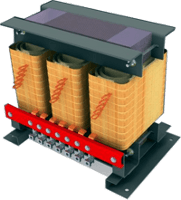Motor Starting Autotransformer
What is a Motor Starting Autotransformer?

Autotransformer starting uses an motor starting autotransformer to reduce the line voltage during the starting period. The autotransformer voltage taps provide a choice of three different starting currents and torques, depending on the load requirements. Motor starting autotransformers for on-line starting of motors are simple and economical. Offering maximum starting acceleration and torque. autotransformer overcomes the two major limitations of on-line starters - high starting current and high starting torque. The selection of a suitable starting method for a motor is becoming increasingly important as additional loads are added to existing utility and distribution systems. In the past, ample capacities were available in the utility networks to support the needs of industry. As well, the distribution systems of most North American industries were established during the industrial and technological boom years. In the 1990’s, the viability for the construction of new electrical generation plants became prohibitive. With lower North American utility generating capacity and increased risks involved in the de-regulation of this utility, stability and voltage drop concerns have become very real issues that face all electrical power consumers.Problem Full voltage starting of motors can produce voltage flicker, mechanical stress to gear boxes or belt drive systems and create pressure surges or water hammer in pumping applications. Starting a motor at reduced voltage can help reduce or overcome these problems. If the load cannot be accelerated to full speed using full voltage and current, it cannot be accelerated to full speed using reduced voltage and current.
Application Solution
There are several factors to considered when selecting the starting equipment for any electric motor driven load. These include, but are not limited to:
- The source of power and the effects the motor starting currents will have on the source and the stability of the system voltage
- The starting and breakdown torque characteristics of the motor (motor speed torque characteristics)
- The motor starting characteristics (torque) that correspond to the motor best suited to the load characteristics at full load and speed
- The starting characteristics of: motor torque load torque, accelerating load torque (load inertia) the motor starting, accelerating and running torque on the driven load
- The available short circuit capacity of the distribution system
- The operating speed range of the connected load.
- Process considerations: shock, vibration, mechanical hammer, the control and maintenance of different starting methods.
The initial inrush currents, locked rotor currents and the resulting torque values produced, are the factors that determine whether the motor can be applied directly across the line, or whether the current has to be reduced to get the required performance to match the load requirements and/or utility line voltage flicker or voltage dip specifications. The major advantage of this method of starting motors are: for hard to start loads, adjustable starting torque, can be used with any standard motors and less strain on the motor. In this system, the first step is connected to one of the reduced voltage taps, which results in a reduced starting current and torque. After a preset time delay, the second step applies full rated voltage to the motor for normal operation. For the same value of line current drawn during the starting period, motors with auto-transformer type starters/panels deliver the maximum starting torque when compared to other type of starters. Autotransformer starting automatically switching between taps of an autotransformer reduces the voltage, current and torque to the motor according to the tap setting used on the autotransformer. There are two very distinctive characteristics of an autotransformer starter:
- The motor terminal voltage is not a function of load current and remains constant during the acceleration time.
- Due to the turn ratio advantages, the primary line current is less than the secondary motor currents. A three-coil autotransformer is connected in a wye configuration and connected to the motor in such a way as to supply reduced voltage to the motor when the line voltage is applied to the Autotransformer.
Several sets of taps are usually available to the user to provide different values of reduced voltage (NEMA standards are 80%, 65% and 50% of the full line voltage).
- Go back to the previous page.
- Use the search bar at the top of the page to search for your products.
- Follow these links to get you back on track!
Store Home | My Account

 United States
United States